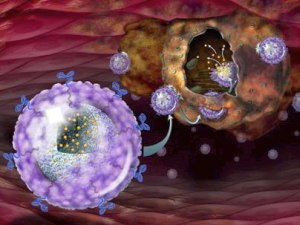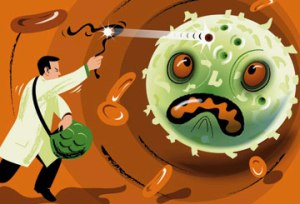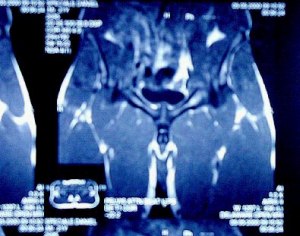Times Online UK (https://www.timesonline.co.uk/) has published an article about the ne developments in the Nano Magnetic particales which can be used to destroy cancerous cells in human body.
Please read the Article which we present here courtesy of Times Online. Pictures are presented from other sources to further enhance reading experience.
 Nano-sized magnetic particles that can be guided to tumours and heated up to kill cancerous cells could offer hope to patients with forms of the disease currently considered incurable.
Nano-sized magnetic particles that can be guided to tumours and heated up to kill cancerous cells could offer hope to patients with forms of the disease currently considered incurable.
The tiny iron oxide particles are essentially “cooked” using a magnetic heating wand that is waved over the affected area. Scientists say the technique would be painless and could even be administered in GP surgeries or outpatient clinics.
“There has been virtually no improvement in survival rates for lung cancer in the last three decades,” said Dr Sam Janes, of the Centre for Respiratory Research at University College London who is co-leading the research. “We’re aiming to target these cancers for which chemotherapy has failed.”
Unlike conventional untargeted treatments, the nanoparticles can be directed exclusively toward the affected cells either by using external magnets, or by attaching the particles to “cancer-seeking” biological agents such as antibodies. Once the nanoparticles are in place in the tumour, they can be heated, killing any cells in their vicinity.
 The technique acts on cancer cells as if they were in a microwave oven. But rather than using microwaves, the heating is achieved by a rapidly changing magnetic field generated by a hand-held paddle-shaped device, known as the MACH (Magnetic Alternating Current Hyperthermia) machine.
The technique acts on cancer cells as if they were in a microwave oven. But rather than using microwaves, the heating is achieved by a rapidly changing magnetic field generated by a hand-held paddle-shaped device, known as the MACH (Magnetic Alternating Current Hyperthermia) machine.
This heats up thousands of iron oxide particles deposited in the cancerous cells by around 6C – enough to send the cells into a state of shock and kill them.
Crucially, because only the nanoparticles are affected by the MACH device, healthy tissue is left intact. The iron oxide particles are easily cleared from the body and already have NHS approval.
 A significant advantage of the technique is that a Magnetic Resonance Imaging (MRI) scan can be carried out to map exactly where the particles go in the body. This will allow doctors to ensure they are localised to the tumour and in sufficient quantity before the heating step takes place.
A significant advantage of the technique is that a Magnetic Resonance Imaging (MRI) scan can be carried out to map exactly where the particles go in the body. This will allow doctors to ensure they are localised to the tumour and in sufficient quantity before the heating step takes place.
“We know that heat kills cancer cells, but you can’t use it systematically without killing the patient,” said Professor Kerry Chester, one of the scientists at the University College London Cancer Institute who is developing the technique. “The important thing with this approach is that you can see where the nanoparticles go and use them for targeted therapy.”
The team of scientists are working on three different strategies for guiding the nanoparticles to tumours.
 For reasons not fully understood, bone marrow stem cells, known as mesenchymal cells, have a strong affinity for lung cancer tissue. Attaching the nanoparticles to mesenchymal cells would allow them to be targeted at lung cancer tumours. In mice, injecting mesenchymal cells and applying the heat treatment was shown to eliminate all tumours in 40 per cent of mice tested.
For reasons not fully understood, bone marrow stem cells, known as mesenchymal cells, have a strong affinity for lung cancer tissue. Attaching the nanoparticles to mesenchymal cells would allow them to be targeted at lung cancer tumours. In mice, injecting mesenchymal cells and applying the heat treatment was shown to eliminate all tumours in 40 per cent of mice tested.
Another strategy is to use fragments of antibodies to transport the nanoparticles. The antibodies can be designed to latch onto specific receptors on cancer cells. The UCL team say this method would be appropriate for treating cancer of the lymph nodes and brain cancers.
The final strategy is using external magnets to draw the nanoparticles to a particular site, like a biological version of iron filings.
The team of UCL scientists will spend the next three years carrying out more detailed animal studies, financed by a £1.6 million “Grand Challenge” grant from Research Councils UK.
At the end of the three-year project, they expect to be ready to take the treatment into clinical trials on cancer patients, and say the therapies could be in wider use within ten years
Here is an Excert from the same Item from The Economis for you to further study this.
What’s your poison?
The trick, then, is to concentrate the TNF in the tumour. That can be done surgically, by a procedure known as isolated limb perfusion. But this is complicated, and the treatment works only in about three-quarters of cases. CytImmune hopes that its method will be simpler. It intends to use Aurimune as a way of delivering TNF to the tumour site, and only to the tumour site, by employing the “leaky wall” effect to get the particles to the right place.
According to Lawrence Tamarkin, CytImmune’s boss, when Aurimune was run through safety trials it was able to deliver doses of TNF that were as high or higher than those which isolated limb perfusion could manage, and without serious side-effects. The only side-effect that has been noted so far is a transient fever that can be treated with over-the-counter medicines.
Calando Pharmaceuticals, of Pasadena, California, is also packing nanoparticles with a substance previously too dangerous to use. In this case the drug is called camptothecin, and the nanoparticle is made from a strand of sugar molecules. As the camptothecin is attached to the sugar molecules, the strand folds up into a sphere, hiding the drug inside as a clenched fist might hide a pea.
The result, called Cyclosert by the firm, is being tested to see if it can prevent the progression of ovarian cancer. Some 150 patients who have completed standard chemotherapy for this disease, which would normally then be followed by a period of what is known as “watchful waiting”, will, instead, be given Cyclosert. Since ovarian cancer often recurs, that will, by dint of comparison with a control group who undergo watchful waiting alone, allow the researchers to assess whether Cyclosert reduces recurrence.
Like Nanospectra and CytImmune, Calando relies on the leaky walls of tumour capillaries to deliver its products. But nanoparticle therapies of the generation after that may be smarter. Dr West has now started attaching antibodies to her gold nanoshells. Since antibodies have specific affinities to particular proteins, any nanoshells covered in antibodies to those proteins found almost exclusively on the surfaces of tumour cells will stick to those cells and no others. That way, when the light is applied, only the unhealthy cells should be killed.
Moreover, Dr West is also working on particles that both scatter and absorb light. These would reveal the extent of any tumour if illuminated with a low-power beam. That would tell surgeons where to point a high-powered killing beam so that no cancerous tissue was missed.
It may, of course, all come to nothing. The war on cancer is being pursued on many fronts, and this is just one of them. But the idea looks promising because it is based on a general principle rather than a specific practice. This means that if one particular version fails, others might still succeed. Cynicism aside, that fact alone is worth the headline.
